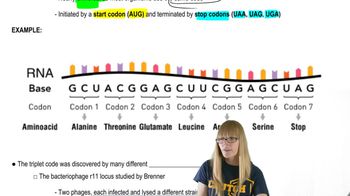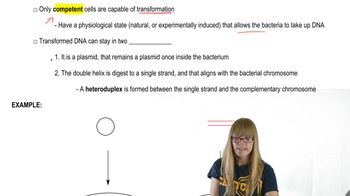Here are the essential concepts you must grasp in order to answer the question correctly.
Genetic Code
The genetic code is a set of rules that defines how the information encoded in DNA is translated into proteins. It consists of sequences of nucleotides grouped into triplets, known as codons, each of which corresponds to a specific amino acid. This triplet nature allows for 64 possible combinations, providing the necessary diversity to code for the 20 standard amino acids used in protein synthesis.
Recommended video:
Triplet Code and Nonoverlapping Nature
The triplet code refers to the way in which three nucleotides in DNA or RNA correspond to one amino acid in a protein. Geneticists hypothesized that the code was nonoverlapping, meaning that each nucleotide is part of only one codon, ensuring that the reading frame remains consistent during translation. This hypothesis was based on the need for a systematic and efficient way to encode a vast array of proteins without ambiguity.
Recommended video:
Experimental Validation
Experimental validation of the genetic code's triplet and nonoverlapping nature was achieved through various methods, including the use of synthetic RNA and ribosomes. By introducing specific RNA sequences and observing the resulting protein synthesis, researchers demonstrated that altering one nucleotide affected only one codon, confirming the triplet and nonoverlapping characteristics. These experiments provided the empirical evidence needed to support the theoretical predictions made by geneticists.
Recommended video:



